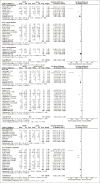The analgesic effects of bilateral superficial cervical plexus block in thyroid surgery: A systematic review and meta-analysis
- PMID: 37601928
- PMCID: PMC10436725
- DOI: 10.4103/ija.ija_806_22
The analgesic effects of bilateral superficial cervical plexus block in thyroid surgery: A systematic review and meta-analysis
Abstract
Background and aims: Thyroid surgery is moderately painful, and many techniques to reduce postoperative pain have been studied. Regional techniques are a part of multimodal analgesia employed for various surgical cases. Bilateral superficial cervical plexus block (BSCPB) is a commonly used regional anaesthesia technique for analgesia for thyroid surgery. A previous meta-analysis by this group had left questions about some facets of the technique, to which further trials have contributed.
Methods: The systematic review and meta-analysis was registered on the International Prospective Register of Systematic Reviews (PROSPERO) CRD42022315499. It is an update to a previously published paper in 2018. An updated systematic search, critical appraisal, and analysis of clinical trials were performed. Trials investigating preoperative or postoperative BSCPB compared to control in patients undergoing thyroid surgery were included in the search. The primary outcome was postoperative opioid consumption. The secondary outcomes were the duration of analgesia (time to request of analgesia), Visual Analogue Scale (VAS) pain scores at 0, 4, 12, and 24 h, postoperatively, rates of postoperative nausea and vomiting (PONV), postoperative rescue analgesic consumption, and intraoperative morphine use.
Results: A total of 31 studies and 2,273 patients were included in this analysis. BSCPB significantly reduced post-thyroidectomy opioid consumption (P < 0.001). Additionally, the duration of analgesia was prolonged following BSCPB. VAS scores for 24 h (postoperatively), intraoperative morphine use, and rescue analgesia (postoperatively) remained significantly lower in patients who received BSCPB. There was also a statistically significant reduction in PONV (P = 0.02).
Conclusion: BSCPB offers superior postoperative analgesia with a reduction in opioid use, reduction in PONV, and improvement in VAS scores.
Keywords: Analgesia; cervical plexus block; postoperative; thyroid surgery; thyroidectomy.
Copyright: © 2023 Indian Journal of Anaesthesia.
Conflict of interest statement
There are no conflicts of interest.
Figures





References
-
- Uhlmann RA, Reinhart HA, Postevka E, Snyder SK, Arenas MR. A review of postoperative pain management for thyroid and parathyroid surgery. Endocrine. 2019;241:107–11. - PubMed
-
- American Society of Anesthesiologists. Practice Guidelines for Acute Pain Management in the Perioperative Setting:An Updated Report by the American Society of Anesthesiologists Task Force on Acute Pain Management. Anesthesiology. 2012;116:248–73. - PubMed
-
- Pandit JJ, Satya-Krishna R, Gration P. Superficial or deep cervical plexus block for carotid endarterectomy:A systematic review of complications. Br J Anaesth. 2007;99:159–69. - PubMed
Publication types
LinkOut - more resources
Full Text Sources
